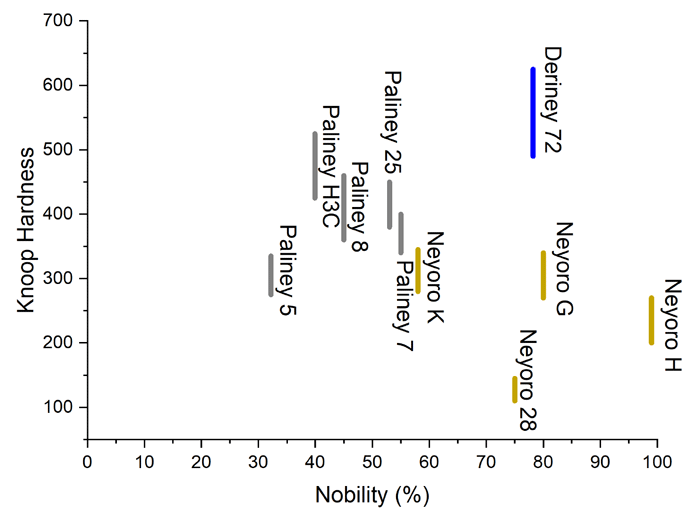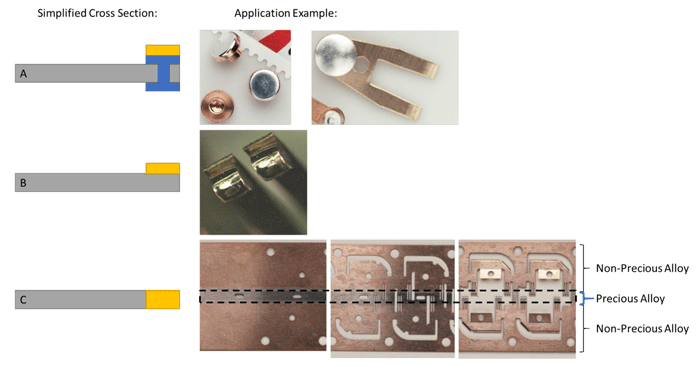Issue 021, November 11, 2021
Grant G Justice, Sr. Research Metallurgist
While the concept may seem incongruous the careful application of precious metal alloys in low energy electrical contacts can result in overall cost reduction. Savings are enabled by utilizing elegant, simpler to manufacture, high reliability solutions permitted by a noble material’s inherent low contact resistance even in extreme environments.
A pervasive application of precious metal contacts is in the fuel level sensors for modern cars and trucks. These sensors are key to the safe and reliable operation of motor vehicles and need to function consistently for years in an environment that is both corrosive and abrasive. It is possible to implement many different solutions to this problem but the relative simplicity of having the key contact points be made of a noble and wear resistant metal is able to keep production costs low and reliability high. Additional information on the use of precious metals and the evolution of fuel level sensors was discussed by Smith et al.[1]
A key part of engineering with precious metals is using the minimum amount of precious metal possible. The first way to reduce precious metal content is alloy selection. Depending on the application, gold, palladium, or platinum may all be viable options; Deringer-Ney offers an extensive line of high-performance gold and palladium alloys and an expanding line of platinum alloys, potentially allowing for the selection of the lower cost precious metal depending on market conditions. Additionally, the precious metals can be alloyed with lower cost semi-precious and base metals like silver and copper to further reduce precious metal content in applications where lower nobility is acceptable. More information on the ranking of the nobility of Deringer-Ney alloys can be found in a previous Tech Brief.[2] The next way to reduce cost is miniaturization. Many Deringer-Ney alloys can be produced as very thin sheet or small diameter wire. Careful alloy design has also resulted in hard alloys that excel in resisting abrasive wear endowing small sliding contacts with long operational lifetimes. A general plot of nobility vs alloy hardness for some DNI alloys can be found in Figure 1.

Figure 1: General plot of Hardness vs Percent Noble Metal for a select group of DNI alloys. Only a partial listing is plotted for clarity. Paliney alloys are palladium based, Neyoro alloys are gold based, and Deriney alloys are platinum based. Hardness varies with final heat treatment and processing, special tempers are available on request.
The final pathway to savings with precious metal is the use of bi-metallic assemblies. These assemblies use a small piece of precious metal at the contact point where nobility is required and a lower cost base metal for the bulk of the assembly. There are several approaches to this depending on the application. One approach is the precious metal can be mechanically bonded to the base metal; a common example of this is a bimetal rivet in a base metal arm, seen in Figure 2A. A second option is to weld pads of precious metal to the contact tips as seen in Figure 2B. A third alternative is to weld a narrow strip of precious metal on to a base metal forming a bi-metallic strip. Contacts can be stamped or otherwise produced from this strip where the precious metal is at the very end of the contact tip as seen in Figure 2C.

Figure 2: Example of various bi-metallic electrical contacts. A) bi-metal rivet in a base metal arm, B) precious metal pads welded to a base metal arm, C) precious metal strip seam welded to a base metal followed by complex stamping, a box around the area of precious metal was added to guide the eye during the late stages of stamping.
The benefits of noble metals in low-energy electrical contacts can be leveraged in a cost effective manner by careful engineering selection of the appropriate alloy and bi-metallic contact design. Small amounts of precious metal in the contact design can significantly simplify the system, reducing manufacturing costs and complexity, and ultimately offering elegant and cost effective solutions.
References:
[1] Smith, E. F III, and Hugh W. Ireland. Design guidelines for automotive fuel level sensors. No. 2002-01-1074. SAE Technical Paper, 2002. https://www.deringerney.com/assets/1/7/Whitepaper_Design-Guidelines-for-Automotive-Fuel-LevelSensors.pdf
[2] Puglia, Megan K. “Tech Brief 003 – What Determines Deringer-Ney’s Alloy Nobility?” https://www.deringerney.com/assets/1/7/Tech%20Brief%20What%20Determines%20Alloy%20Nobility%20r1.pdf 2020-12-16
